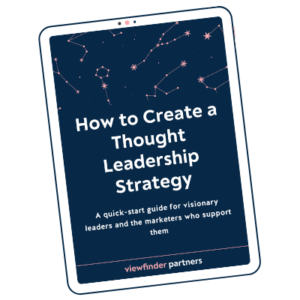“I don’t need a process. I just come up with ideas.”
“No need to waste time on strategy. Let’s dive in and we’ll figure it out as we go.”
“I don’t want to be pinned down to one idea. It will change over time.”
After working in thought leadership for ~10 years and talking to many, many leaders about their big ideas…I know these conversations all too well.
Why do we avoid strategy?
Why are people so resistant to writing down their ideas? Why do we avoid documenting a “strategy” for content, when we’re eager to define a strategy for other parts of the business? Our sales strategy wouldn’t be “we’ll see what happens and hope it all works out,” so why do we leave thought leadership to chance?
Maybe it’s because people think about their content and messaging as more emotional and personal than something you could document in a Powerpoint presentation.
Maybe it’s because thought leadership is often an afterthought. Who has time to build a personal brand? Can’t we get the intern to handle that?
But usually, it’s because documenting our thought leadership strategy — refining all of our ideas into a few clear words that other people can see and understand and use — feels overwhelming, impossible, and like the perfect recipe for raging imposter syndrome. It’s easier to be vague and to tiptoe around a general idea than to map out exactly what we mean.
But I’ve learned, over and over, that committing to ✨the process✨ of thought leadership strategy is completely worth it. And often, the process of discovering your most important ideas involves moving through that painful imposter syndrome, second-guessing yourself, challenging your beliefs, and coming out on the other side with a stronger confidence in your own ideas.
How to define your thought leadership strategy
Recently, I’ve been using a few new exercises to help my clients land on their best ideas.
1. Do you have a verb?
Most of the time, someone comes to me with an idea they’re excited about. But they haven’t been able to do much with it yet. And that’s because their idea is a noun, but they don’t have a verb.For example, let’s say your idea is “creativity.” Or “change.” Or “the future of work” (my favorite no-verb idea to pick on).
Okay. Cool. You’re interested in that noun. But what do you think about it? Do you think it needs to be radically disrupted? Do you love it? Hate it? Should we be afraid of it? Do we need to approach it in a new way? What do we need to do with that noun?
We need a verb.
After asking more questions and having a longer conversation about their big idea, we can usually come up with a verb — and better yet, a complete sentence!
“Creativity” → “Find creativity in unexpected corners.”
“Change” → “We need to start anticipating and planning for change in every element of our business, starting with our people management.”
“Future of work” → “The future of work will be driven by a new generation that demands work that has purpose and meaning.”
When you give your idea a verb, you take a stand. You can start an actual conversation with nuance and opinions and evidence.
2. What do you want to be known for?
Maybe someone has a hard time finding their verb. Or they have a verb, but it’s still pretty generic and half-baked. “Create change.” “Build empathy.”
I help them go a little deeper. I ask: What do you want to be known for? What ideas should people associate with you? When someone says, “Oh, I’ve heard of her. She’s the one who’s all about ______,” fill in the blank.
And here’s the one that really makes people think: If you were giving a commencement address, what would you tell the graduating class?
When we think more aspirationally, we can unlock the values-driven ideas that are most important to us.
“I want to open doors for diverse leaders by changing the way we recruit.”
“I want people to know about my framework for leading with humility by listening more than talking.”
3. What’s missing from the conversation?
Finally, some people think best when it’s in comparison to others. This works best for disruptors and challengers.
I ask: “What is everyone else getting wrong? What are people missing? What do you need to add or change to the conversation?”
If I’m talking to a leader who is all about driving change, they will have a very clear answer to this question.
“Everyone’s talking about the future of work, but they’re focused on where we work. We need to focus on….”
See why strategy is worth it?
When I talk about “thought leadership strategy,” I’m not talking about months of creating binders and charts and iron-clad frameworks. Really, I mean asking these questions to understand the core ideas and figure out how we can share them in the most compelling way. Creating a strategy is about respecting yourself enough to polish your ideas before you present them to new people.
And when we skip strategy, we have to figure out the answers to these basic questions while we’re creating the content. If you’re starting a podcast or pitching to Harvard Business Review or getting on stage, wouldn’t you rather answer these questions and refine your strategy before you do that?
I know I would.
If your team is ready to invest in thought leadership strategy, I developed a *new* way to do it. Get the brain power of 4 thought leadership strategists in a Find Your Focus session. We take your idea from flat to fantastic and set you up for success in your thought leadership.






